HelpMaster v17
v17 is another major new release of HelpMaster, and our most ambitious to date.
It features vastly improved functionality in key areas, as well as a completely re-written web portal that delivers a new request catalog system.
December 2018 Release
What a year of releases! We’ve really hit the code hard this year and delivered some fantastic features, and 2019 will be no different as HelpMaster continues to evolve and improve. This will be the last planned release of 2018, and in the December release we’ve concentrated on performance, refinements and the Explorer for the web portal.
Web Portal Staff Explorer
The web portal now features the Explorer screen for staff logins. The Explorer is similar to the Desktop version, including job queues for personal jobs, unassigned, other staff members and saved searches! It’s a version 1 version of the Explorer, so watch this feature continue to evolve in 2019.

Faster performance for the web portal
The web portal is now even faster due to some optimizations in caching and other performance tweaks.
Control Sets
Lables within Control Sets now have additional formatting options such as backcolour, forecolour and size. This allows you to do things like this.…
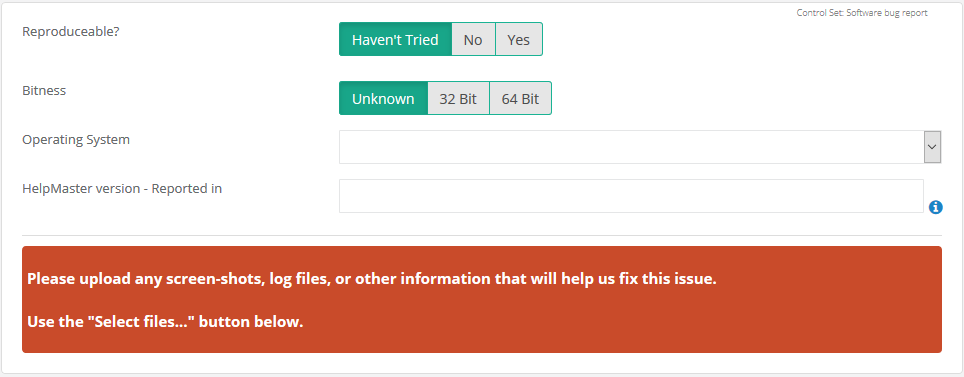
Improved Billing Tab for jobs
The billing tab for jobs has been improved to allow “Billing Managers” to quickly and easily adjust billing information for each job. The billing tab will now display a side dock-panel that will allow instant adjustment to individual actions, whether they were marked as billable or not.

Miscellaneous Fixes
Various miscellaneous fixes and updates were also included in this release.
November 2018 Release
The November 2018 release includes some re-working of the workflow objects, including a new "Workflow Break" object. Web-enabled job templates that rely exclusively on control sets for user data capture also have a great new feature. We've also fixed some bugs, added some change management options and updated some third-party components that HelpMaster uses to increase performance and reliability.
Workflow
A new workflow object - called the "Workflow Break" is now available to be used in workflow to stop the next workflow object from automatically running. This is very useful when designing workflow that transfers from one team to another, or when you need to prevent the next workflow object from executing automatically.

More email tags for the simple email object. The email workflow object now contain several built-in email tags that can be used to compose email. These include the job number, as well as details about the primary client.
Workflow styling and visual presentation continues to be refined\
Change Management
The “Emails” tab of the change management screen now include a new email template type for “Approval Result”. This email template will be sent to all persons that were involved in the approval process upon determination of a vote result.
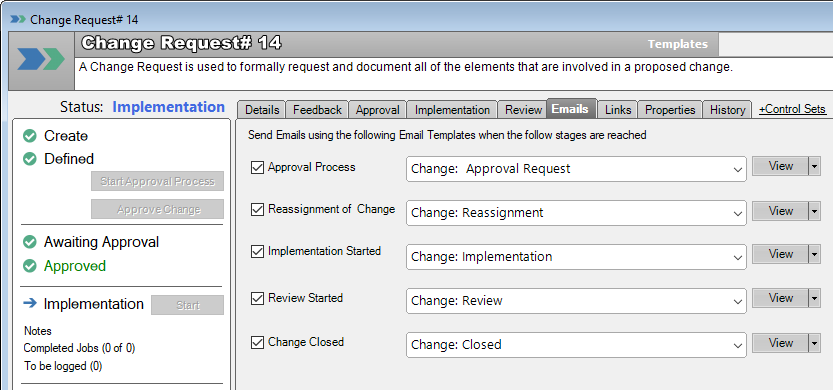
When creating a new change record, you can now “Save, and start the approval process” via a single button/action.
Several fixes have been made to the change management process
Jobs and Job Templates
Improved the summary text box to automatically expand based on its content, relative to the screen size.
Job templates can now be configured as “Web Forms”. This setting enables the summary and the details of a job to be updated with values from control-set data that is entered by the user when logging jobs via the web portal.
New Quick re-assign jobs from an unassigned job queue.

Fixes
Email Template usage count was not always incrementing.
Control set email tag replacement.
Correct sorting for Triggered Events “Next Run” column.
Plug-in for Google Maps updated.
Update Telerik controls to latest version.
Improved the sample database for better consistency and example workflow.
October 2018 Release
The October 2018 release of HelpMaster concentrates on workflow and the web portal.
Here’s a summary of some of the highlights. For a specific list of issues addressed, see the detailed version history change log.
Workflow
All workflow objects have been re-styled for better colour matching, less colour blends and a cleaner look and feel. Much better!
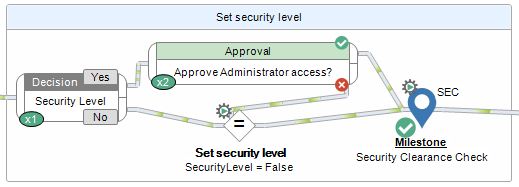
All workflow objects now have new icons that are more consistent with other icons within HelpMaster. Below is a sample of some of the workflow objects.
![]()
A new workflow panel is now used to control workflow. The workflow panel replaces the "Workflow" menu that appeared on the job screen. This changes the whole look and feel of the workflow feature in HelpMaster and is the best thing to happen to workflow since it was introduced.

New workflow object - “Simple Approval” is now available. One or more approval objects can now be configured within a workflow and these can be used to branch the workflow depending on the result of the nominated approving person. Each approval object is configured with an Approver, and a short message stating the nature of the approval request. The approver is emailed the approval request which contains a link to the web portal where they can approve, or reject the request.
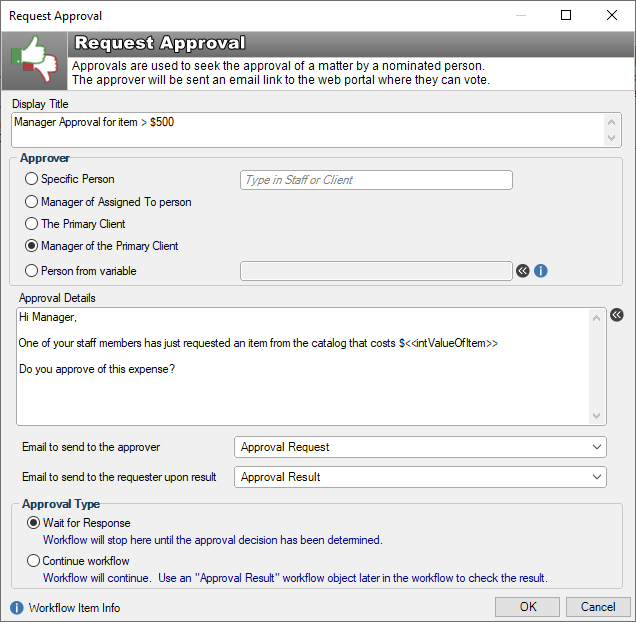
Approvers can be selected by name, or derived from a workflow variable. This allows for dynamic values to be entered according to the workflow process.
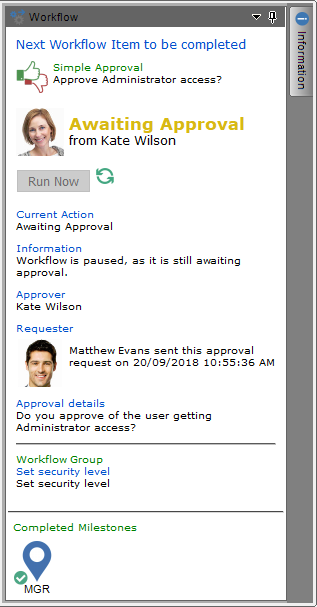
The new workflow display panel will show the status of the approval for the job.
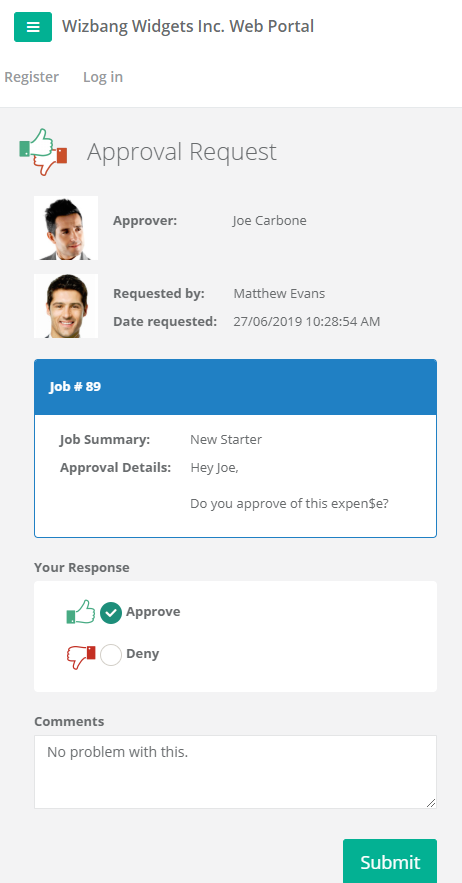
Approvers click on the link emailed to them to approve or reject.
Change Management
“System Affected” is a new set of fields that can be added to change management templates, and used within the change management process. This is a drop-down box / text box pair that can be used to store information about what system is affected in a change. The values of the drop-down box are configured via the System Administration > System Codes screen.
Web Portal
The web portal continues to develop with more functionality with each release.
Staff logons to the web portal now show an “Explorer” menu that displays all active jobs assigned to them.
Staff logons to the web portal can now update jobs via a web “Action” screen. This is similar to the desktop functionality.
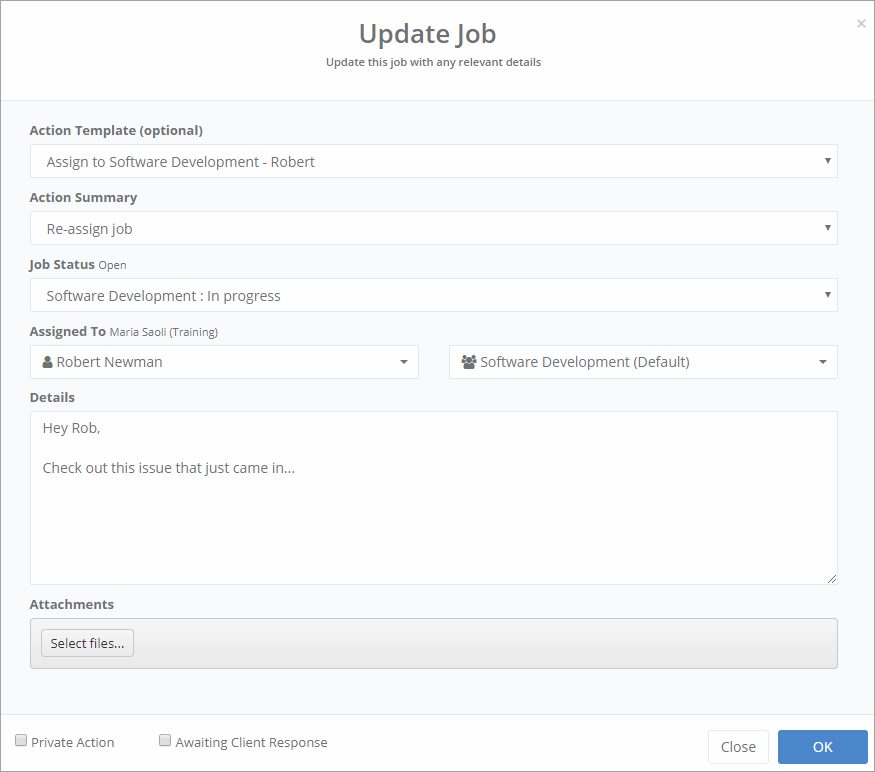
Attachments linked to jobs, action and knowledge base articles are now displayed as thumbnails, and can be downloaded/viewed.
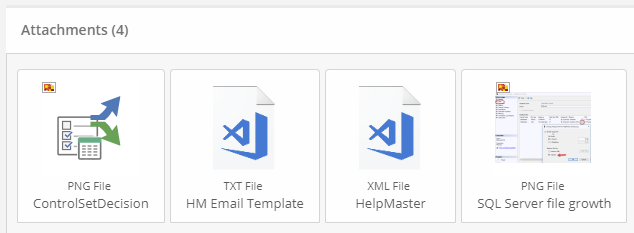
The new approval request screen is now available for nominated "Approvers" to use.
A new “Go to Job#” box appears on the home screen for logged in users. This gives a quick and easy way to look up existing job numbers. Similar to the desktop function.
Fixed several formatting issues
Fixed the error logging and viewing screen (System administrators only)
Sample and Blank databases
The sample and blank databases that are created via the Database and Reports Wizard have been improved for better default content. The sample database include a new “HR Employee Onboarding” workflow that highlights some of the new capabilities of the workflow engine.
August 2018 Release
The August 2018 release of HelpMaster continues to build on product stability, performance and features.
Here are some of the highlights. For a specific list of issues addressed, see the detailed version history change log.
Workflow
Improved email objects. Email workflow objects can now be addressed via variables. This is handy if you extract, or create an email address as part of the workflow leading up to the email object.
Improved scaling and performance with large workflows.
New grouping object. The ability to group workflow objects into named groups. This feature will continue to improve in subsequent releases and be used in an enhanced new workflow display.
Change Management
Change Management continues to evolve quickly.
Change Finder. Similar to the Job Finder, but for changes. Search for changes using criteria and view the list of matching changes
Improved History tab. The history tab now displays more information about updates and amendments to changes. History columns now include “When”, “Change Status”, “Who”, “Assigned To”, “Implementer” and “Reviewer”
Updated UI. Additional tabs now have similar styling to jobs and other entities. Click on the “+” link to add the corresponding tab. This UI element makes it easier to determine if a change has this information or not.
New Email tab. This tab displays and controls all of the email notifications that can be sent for each stage of the change process. Email can be automatically sent at the following stages:
- Approval Process - starting
- Reassignment of change
- Implementation stage - starting
- Review state - starting
- Change closure

New options for re-assigning, changing the implementer, and reviewer. Easier and fully tracked.
Web Portal
Upgraded Masony Javascript plugin.
Fixed issues with web-enabled Control Sets. Styling, fonts, visibility etc.
New “Mandatory” checkbox for control sets. Ideal for use in “Do you agree?” style forms.
Miscellaneous CSS and HTML tweaks for better performance, appears and browser compatibility.
Ability to hide the job summary and details for a cleaner job-logging experience for the user.
Desktop
Search screens for clients, sites, assets etc. All search screens should now open and perform much faster. We've optimized the code and user interface for a much faster experience.
Lots of minor tweaks to the Control sets properties and designer.
Ability to open the control-set designer directly from an entity.
Fixed high-resolution issues with DPI settings set to higher than 100%.
Many of the drop-down lists are grouped according to their system type for better identification and ease of use.
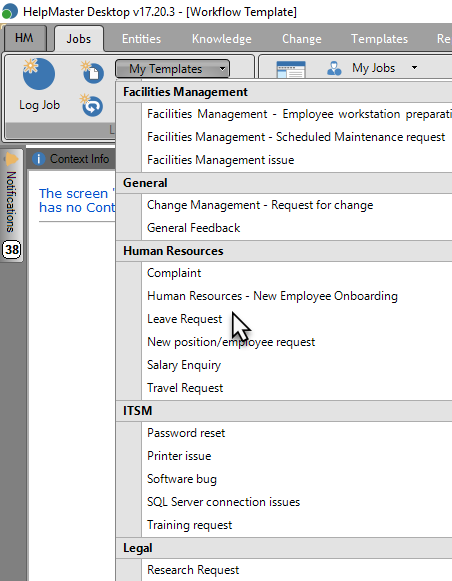
New right-click feature to automatically set the size of all columns within a listview.

Active Directory
LDAP Query filters
Users within Active Directory profiles can now be filtered using LDAP query expressions. This makes it easy to target just a group of users within an OU. eg. Only retrieve people called “John”, or who have an email that has a particular domain etc.. This allows for much finer filtering and granularity when synchronizing users.
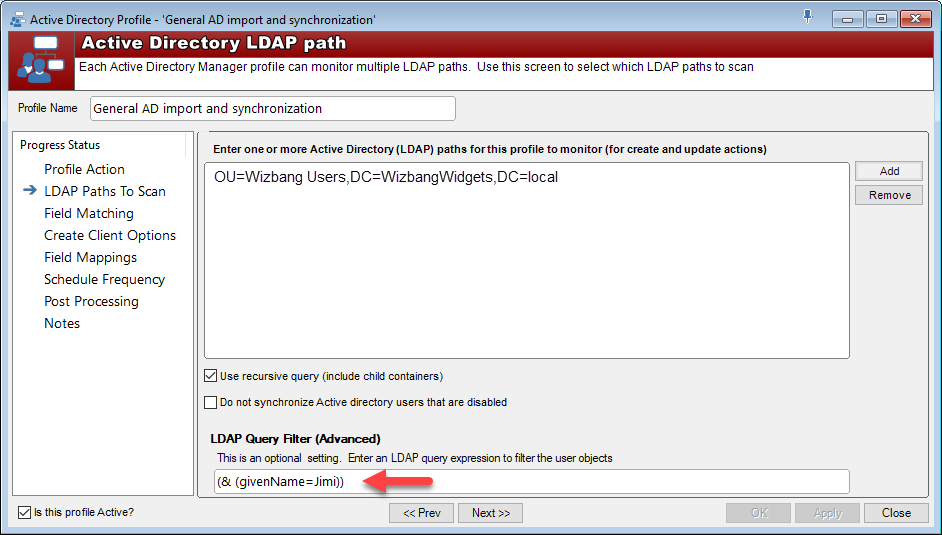
Post-processing SQL
Each profile now has has the ability to run SQL scripts after user objects are created or updated. This allows for custom post-processing on these newly updated clients.
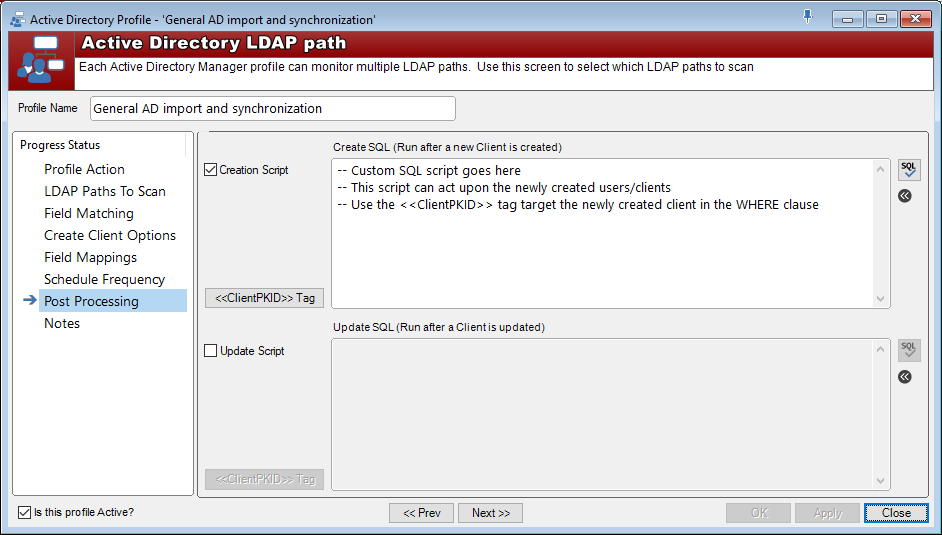
Email Manager
Re-factored code to improve stability, better error logging and checking.
Fixed potential memory leaks for Email Manager which was causing the service to hang.
Triggered Events
Triggered Events now include the ability to search and filter via Control Sets for that entity type.
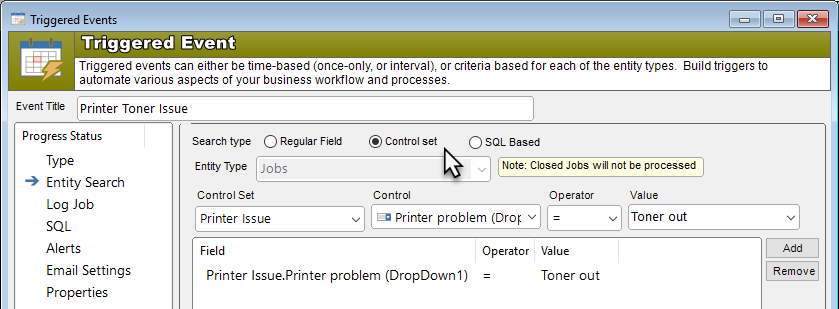
For a full list of fixes, refer to the version history change log.
April 2018 Release
The April 2018 release of HelpMaster is a significant release with many fixes and improvements in it that have been reported since the initial release. Below are some of the fixes and improvements that have been added since the initial release.
Workflow
Workflow has received significant development attention for this release. Workflow is fast becoming a popular feature of HelpMaster, and ties in very well with the new web request portal and control sets.
Updates include:
- Workflow drawing/painting speed has improved. Very large workflows caused a slow paint/refresh.
- Improved scrolling and moving around large workflows - click and hold the mouse wheel to move around the workflow.
- Any workflow objects that use variables have been improved. Variables can be created and modified directly from within the workflow object.
- Variables can be set, updated and have default values attributed to them.
- Improved linking and unlinking of workflow objects. When a new workflow object is added to the designer, you can now move the object over an existing connector line to link it in-line. This makes it much easier and quicker to build workflow.
Send Email
Email can now be sent via an existing Email Template, or via a simple email composed right from within the workflow object. Email can include any workflow variables as tags. Additionally, if using an Email Template, these can use the new control set email tags for great email customization. See Email - Send Email via Workflow
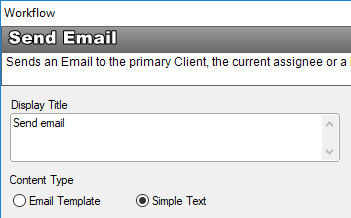
Control Set Branching
Control Sets have fast become the new standard for capturing information via the web or desktop. This new workflow object allows you to branch the workflow based on the evaluation of a field within a control set. Combine this feature with the new web request portal that uses control sets, and you have a very powerful and flexible business process solution.
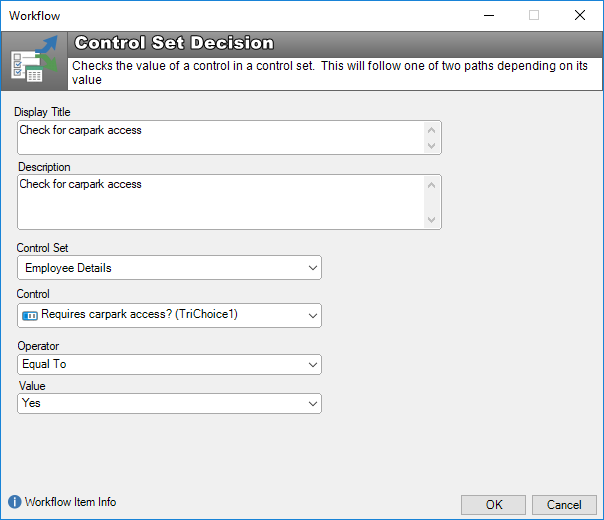
Improved Action Template workflow object
Action Templates workflow object can now over-write existing Action Template data. This means you can create several generic Action Templates, and then adjust them via workflow depending on the application. This cuts-down the need for creating many Action Templates. This include the Action Summary, Job Status, Assignment as well as the Action Details. Furthermore, the action details can include workflow variables.

Improved Job Logging
Logging a new job from workflow has been improved so that the parent job (the originating job running the workflow) can pass its control sets through to the child job (the newly created job). This is very handy if you have a web-request job that captures end-user data via means of a control set, and then that information needs to be passed to other team members via a new job.
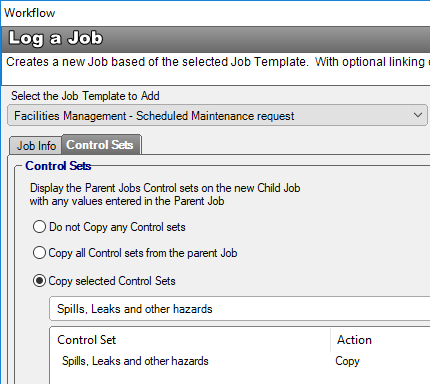
Change Management
Change Management was new for the inital version 17 release, and it has recieved a lot of improvements and refinements based on client feedback.
- The “Feedback” tab has an improved layout and better explanation of the voting processes that was used.
- Change Requests can now have one or more Control Sets linked to it, similar to jobs and other entities. This really gives you the power and flexibility to capture and store whatever data you need for a change request.
- Change Requests can now be assigned to skillgroups - similar to how a job can be assigned to a skillgroup. Changes will appear in the Explorer
- Lots of fixes, refinements and overall refinement of the Change Management feature
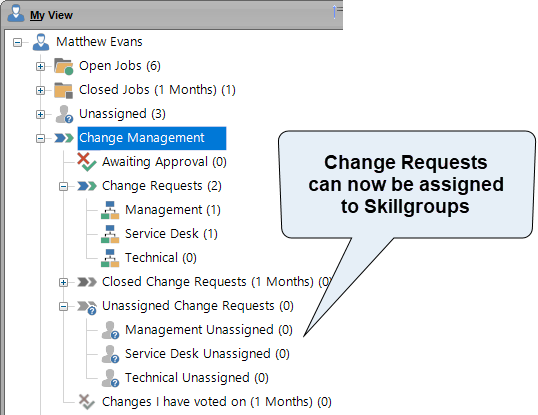
Web Portal
The re-designed web portal was also new for the inital v17 release. It has also received a lot of fixes, performance tweaks and styling updates.
- Fixed several styling issues with lables (fonts, bold/regular, resizing)
- Update styling of checkboxes, tri-choices and other controls for better contrast and consistent theming
- Improved layout of several options
Control Sets
Control Sets were another new feature for the initial release of version 17, and this feature has also received a lot of fixes, tweaks and improvements based on user feedback.
- Improved layout of control set administration form.
- The properties panel is now re-sizeable with a vertical splitter bar
- Inserting new controls will now insert at the current cursor location
- Deleting parent control set objects will now delete the entire hierarchy of controls, rather than having to do it one-by-one
- Checkboxes now have a mandatory property. This makes it possible to implement a web "Have you read the terms and conditions?" style question
- Tool tips for the web were not working - these are now fixed (and improved)
- Labels in the Desktop + Web have been improved for formatting and sizing
- All controls in the Desktop now re-size better and display in the users' selected font
System Administration
Several system administration tweaks were made to improve the overall configuration.
Bug Fixes
Many fixes have been made to issues that have been found and reported since the initial v17 release. Thank you to everyone that reported an issue and worked with the development team to correct them.
Performance Improvements
There have been many performance improvements since the initial v17 release that cover many aspects of the application.
- Improved database performance for many of the common queries, joins and searches
- Improved workflow drawing speed
- Improved error trapping for common functions
Reporting
Improved PowerBI HelpMaster dashboard. Contains new visualizations, better database optimization and refined schema.
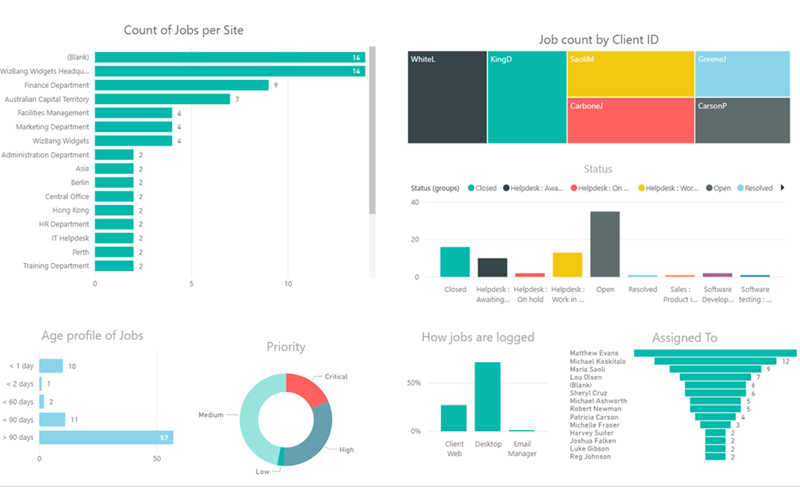
November 2017 Release
New menus
The toolbar menu layout has changed to offer a better distribution of functionality grouping. On the left is also the “HM” menu that replaces the “User” menu and also includes additional screen. There is now a dedicated menu for Knowledge, Change, and Web functionality.

Client linking improvements
Clients can now be linked to more than one site! This is great if you have clients that move around between offices, or sites and you need to track that. This makes the configuration of HelpMaster and the logging of jobs much more intuitive and natural. We have improved the job-logging process to make this even simpler - see below for further details.

New visual indicators and “quick pick” boxes are now used to view and select clients, sites and assets throughout HelpMaster.
Auto-initials for entities without images
Whenever a client, site or asset does not have an image, HelpMaster will display a 2-character summary of their unique ID, similar to the way a mobile phone app does. This will assist in quickly identifying entities that do not have an associated image.
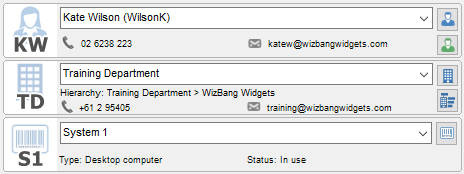
Workflow improvements and new capabilities
The workflow functionality has received a major upgrade to facilitate more complex business processes.
New workflow items include:
- Script-based direction flow. Used for programmatic control over which way a workflow should progress
- Variables and Variable modifiers. Used to store values and then re-use/modify/evaluate as part of the workflow
- Control Set Validation. Used to check that data is present, or correct
- Milestones. Used to measure progress within a workflow. Great for reporting and automation
- Log a new job. Jobs can be logged silently, or interactively, and options for automatic linking allows for some inventive workflow configurations
- Improved script control Now supports Powershell scripting! Lots of power and options here. Great for system administrators and network administrators
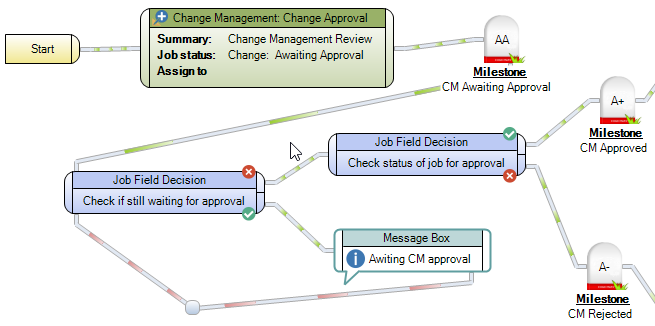
Workflow auditing, history and documentation has been improved. Each workflow, item, template and flow is now fully logged so that you can see what has happened.
Control Sets
Controls sets are similar to custom data fields, but with special powers. Create as many “control sets” as you like - name them, and use them to capture information. Think of them as mini-forms that are used to capture data. Control sets can be added to all of the main HelpMaster entities (clients, sites, assets, jobs) and will appear on the “Control Sets” tab. You can also add multiple control sets to each entity.
Controls sets will open up a whole new level of data capture and use within HelpMaster. Link them to the new workflow objects, and use them on the new web portal to capture all of the information that you require for each job type.
Controls sets will change the way you configure and use HelpMaster. Not to be overlooked!
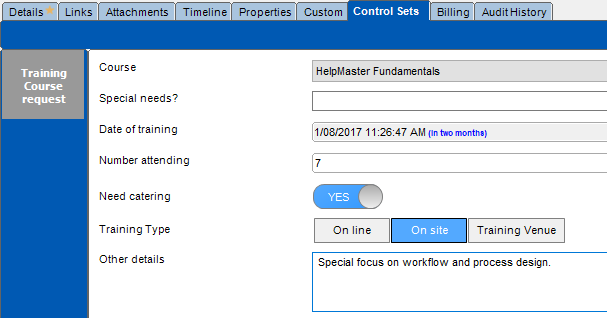
Re-designed job screen
The job screen has been re-arranged in order to display new information and optimize the layout. Included on the front tab is now Client, Site and Asset information. This makes it much easier to see the context of a job and what's linked to it. The process of linking an entity to a job is improved via new quick-pick selectors (see below).
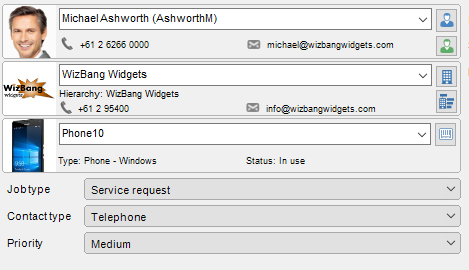
New quick-pick selectors for clients, sites and assets
In addition to a new layout, the job screen (and all other "Links" tabs) now features a "quick pick" selection for Clients, Sites and Assets. This allows you to quickly link an entity without having to open the full search screen - now you simply start typing and selecting from the list. Much better!

Completely re-designed and re-built from scratch Web Portal
The web portal has been totally re-built from the ground up using the latest in web development tools and technologies. We re-architechted the code, the infrastructure and everything else to deliver a new visual interface with some powerful new features. Your team and customers are going to love the new web portal. It’s fast, looks great and delivers some exciting new features.
The new web portal utilizes the new template catalogs (see below) to deliver a new-look request system that makes logging a new job/request so much easier and intuitive. The new web portal is built on HTML 5, CSS 3, Bootstrap and features many new web tools and technologies that will allow the product to develop and improve greatly in subsequent releases.
Important notice!
The initial release of HelpMaster v17 will only include web functionality for client based requests and ticketing. The full staff web functionality will be available in a future release.
Request Catalogs
Request catalogs are groupings of Job Templates and Knowledge Base articles which can then be used to display options via the new Web Portal to your clients. Template catalogs make it easy to group business request types into similar groups and then make it available for staff and clients to access.

Read about Request Catalogs
New grouping category
A new drop-down box now appears on all entities, and profiles. This feature is used to group things together which makes administration and future feature improvements possible.
New “Client Action required” state
In the desktop edition of HelpMaster, staff now have the ability to mark an action as “Requires client response”. If the client logs into the web portal, they will see their job with a clear marker informing them of the update. This feature works with the new Job State (see below)
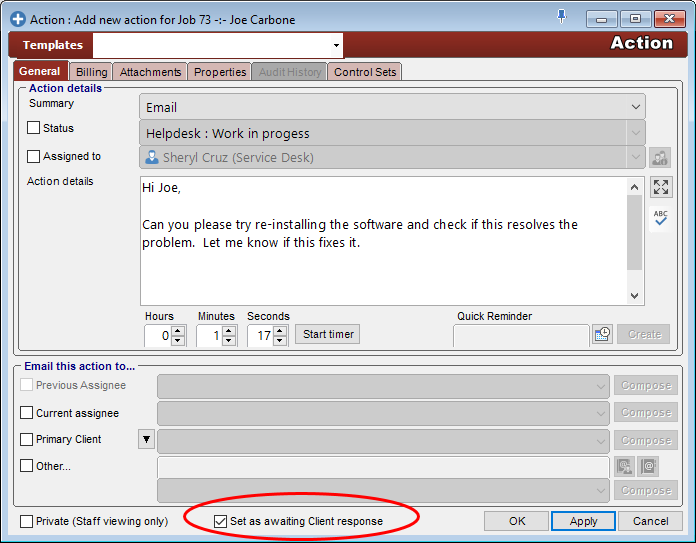
Job State (for Desktop + Web Portal)
A new job state indicator feature is now available. Job State will help both staff and clients to quickly identify the state a job is in. This is very helpful to visualize which job require attention, which jobs have been updated, and which jobs are new. For clients using the new web portal this will give a clear indication that their job has been updated by service desk agent, and requires their response. Conversely, when the client does response, the agent (staff member the job is assigned to) will also be notified by changed state indicator.
The Desktop Explorer screen for staff
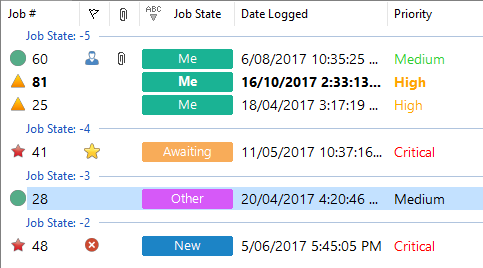
The web portal for clients

More flag types, and flag integration
There are now more flag types to use for marking jobs. In addition to the regular coloured flags, there are now new icons that can be used to “flag” a job. These are searchable via the Job Finder, and the Email Manager can also flag them as part of the post-processing action. Very handy as another mechanism to classify/organize jobs visually.
See Flagging jobs
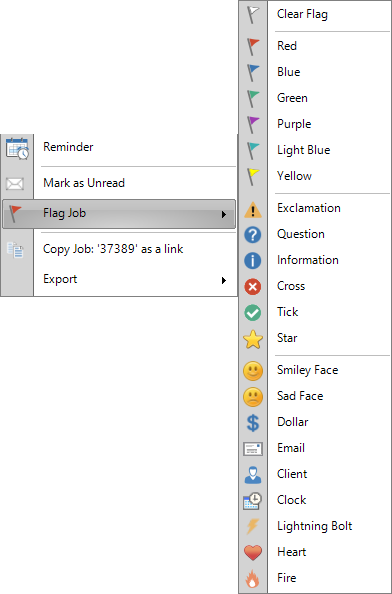
Change Management
Change management comes to HelpMaster!
A new top-level “Change Management” feature allows you to define a request for change (RFC), define a change advisory board (CAB), and then define an implementation. Each change can be “approved”, or “denied” based on the input from the CAB, and a new “Change Management” section now appears in the Explorer screen for each staff member.
Change requests can be built into a workflow process, and linked into other change requests to form more complex, or multi-stage request approvals.
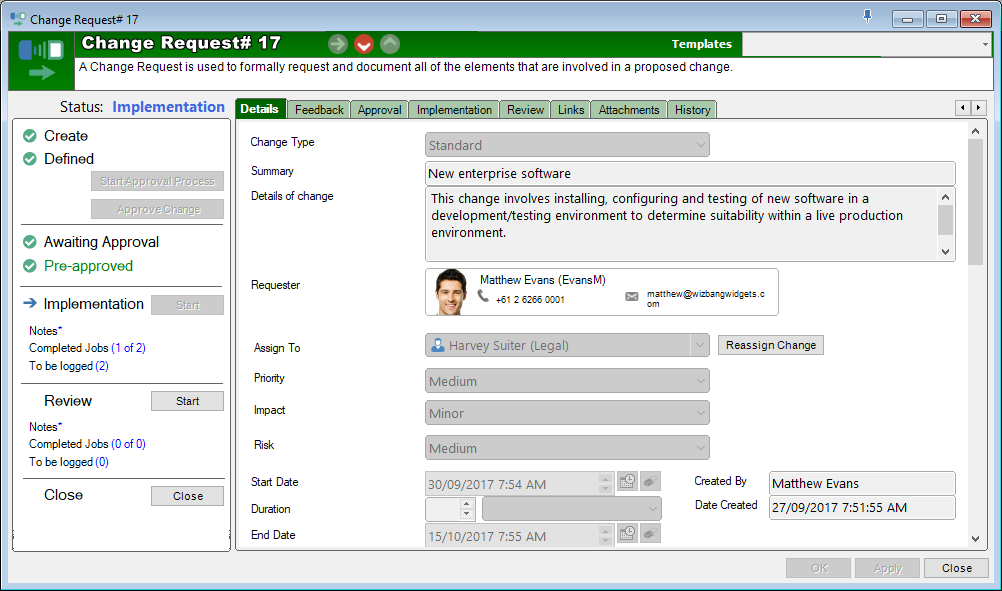
Read about Change Management
Miscellaneous fixes and improvements
As usual, the latest version of HelpMaster contains many “under the hood” improvements, fixes, and performance tweaks. We have fixed a lot of bugs, improved the load time of many screens, improved the screen flickering and drawing issues, and tried to deliver an improved user interface.
Feedback
Was this page helpful?
Glad to hear it! Please tell us how we can improve.
Sorry to hear that. Please tell us how we can improve.